Radar sounding is opening up a planet’s third dimension
17 April 2008
ESA’s Mars Express radar sounder, MARSIS, has looked beneath the martian surface and opened up the third dimension for planetary exploration. The technique’s success is prompting scientists to think of all the other places in the Solar System where they would like to use radar sounders.
No matter how accurate a camera is, it can only map a planet’s surface. To retrieve information about the underground realm, planetary scientists in the past would have thought it necessary to land on the surface and start digging. But that would only be good for a single spot on a large planet and the first few decimetres of the surface.
Martian south polar layered deposits |
MARSIS was an experiment in every sense of the word. “It was a leap into the unknown,” says Ali Safaeinili, MARSIS co-investigator at the Jet Propulsion Laboratory (JPL), California, USA.
No one had ever used a radar sounder from orbit on another planet before. So the team could not even be sure whether it would work as planned. The subsurface of the planet might have been too opaque to the radar waves or the upper levels of martian atmosphere (ionosphere) might have distorted the signal too much to be useful. Thankfully, none of this happened.
“We have demonstrated that the polar caps at Mars are mostly water ice, and produced an inventory so now we know exactly how much water there is,” says Roberto Orosei, MARSIS Deputy Principal Investigator, IASF-INAF, Italy.
MARSIS sending signals and receiving echoes |
A MARSIS-type experiment in orbit around Europa could probe its icy crust to help understand the puzzling features we see on the surface. It may even see the interface at the bottom of the ice where an ocean is expected to begin.
At Saturn’s moon, Titan, penetrating radar could be used to measure the depths of the hydrocarbon lakes that the Cassini spacecraft has detected. It could also probe the structure beneath the enigmatic geysers that Cassini has observed on another one of Saturn’s satellites, Enceladus. “Radar sounders are very well suited to exploring icy worlds,” says Orosei.
MARSIS fully deployed |
MARSIS has served as an excellent example of international collaboration between Europe and America. Increasingly, such collaborations are set to become a positive feature of our joint exploration of space.
For more information, read the full article on the ESA Mars Express pages
The MARSIS technique could prove invaluable for studying the stability of Antarctic ice sheets here on Earth, read more on ESA General Studies Programme pages
Original here





No comments:
Post a Comment